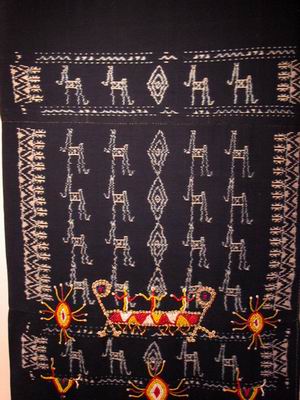Ikat Cloth: Indonesia
On woven fabric, which is made everywhere from Sumatra through the eastern islands, the most characteristic element is the key-shaped figure combined with other geometric figures.
The rhombus (an equilateral parallelogram usually having oblique angles) frequently occurs together with straight lines, equilateral triangles, squares, or circles, which permits an enormous number of variations, including stylized representations of human beings and animals.

Each island or region has its characteristic patterns, which serve to identify the area in which the cloth is made.
The art of weaving is highly developed. It includes the famous ikat method, in which the thread is dyed selectively before weaving by binding fibres around groups of threads so that they will not take up colour when the thread is dipped in the dyebath.
This process may be applied to the warp, which is most common and is found in Sumatra, Borneo, and Sumba. Weft ikat is found mainly in south Sumatra, and the complex process of double ikat is still carried on in Tenganan in Bali, where such cloth has great ceremonial significance.